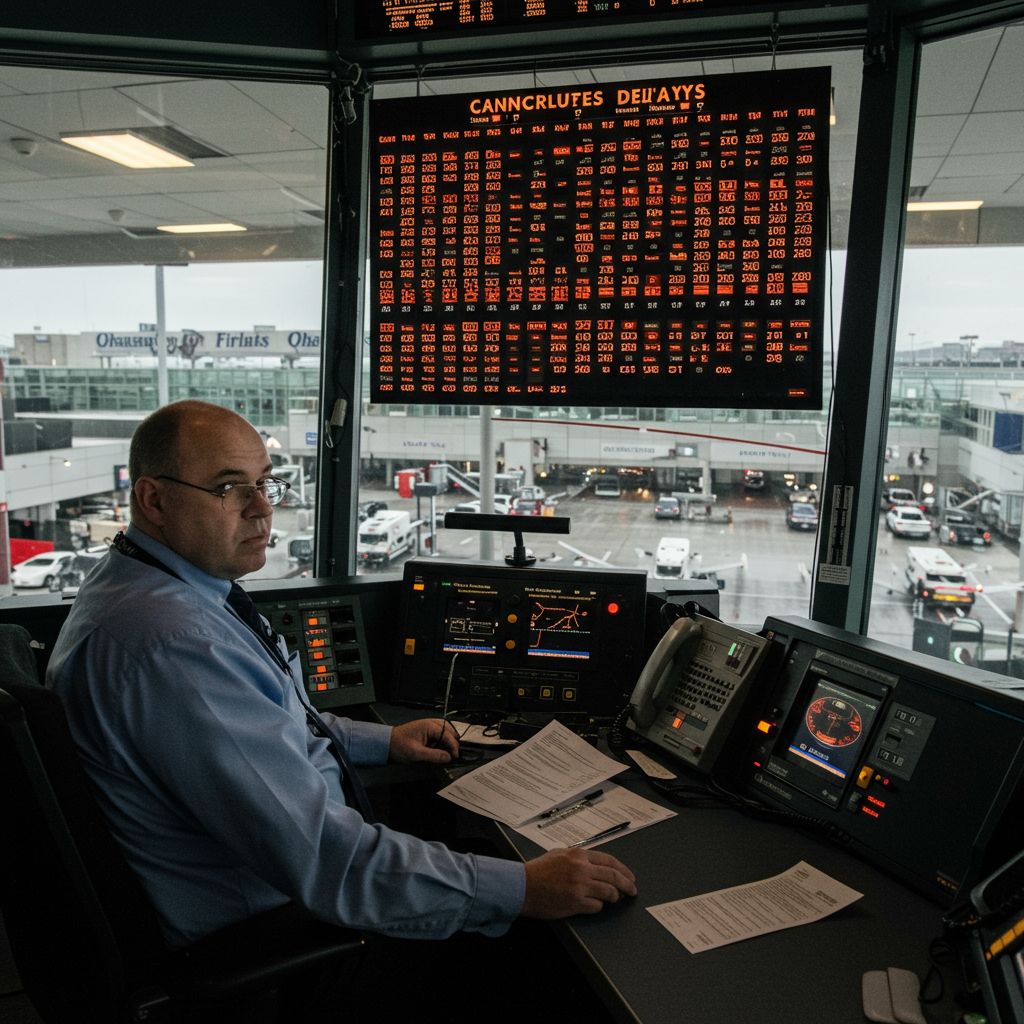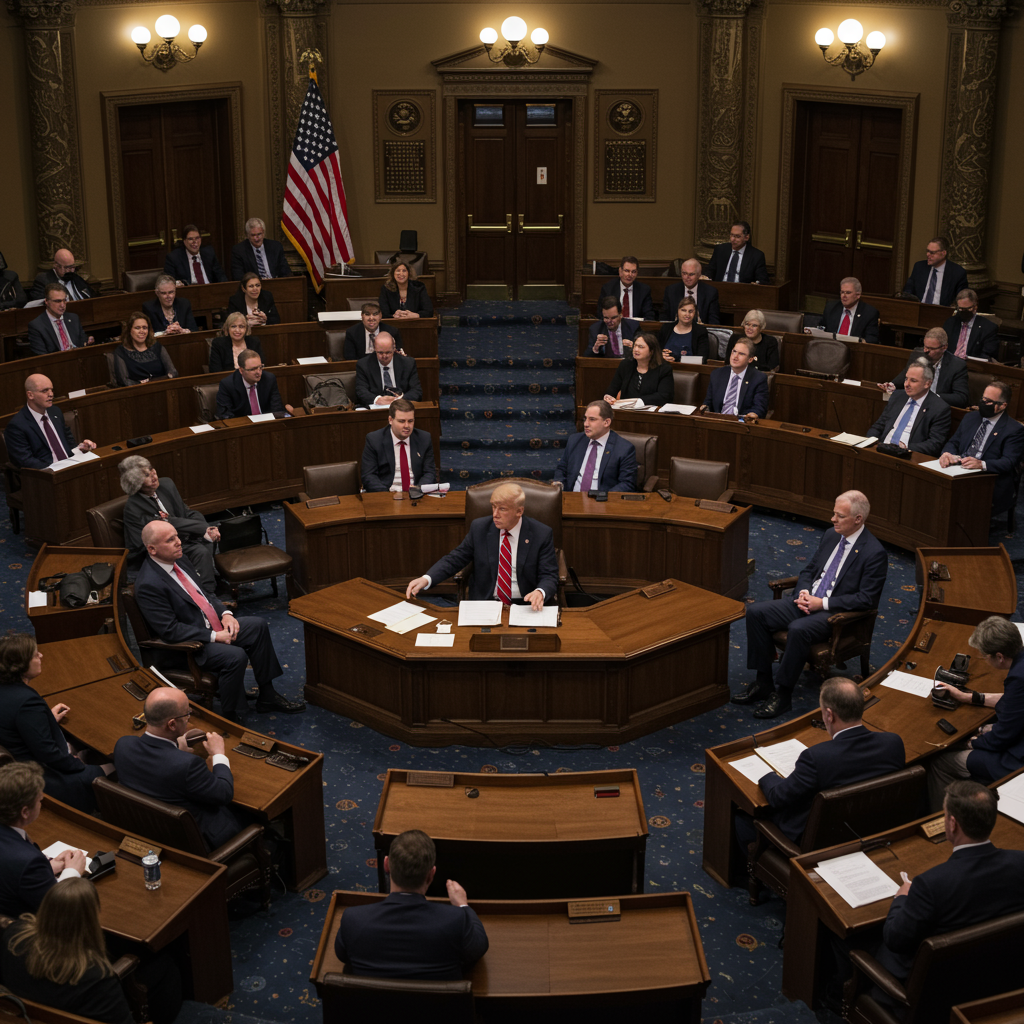As the crucial holiday travel season approaches, travelers across the United States, particularly those planning flights through major hubs like Chicago, face growing uncertainty. The Federal Aviation Administration (FAA) has implemented drastic flight reductions and airspace restrictions, effective immediately, a direct response to severe air traffic control staffing shortages exacerbated by an ongoing government shutdown. This unprecedented move aims to prioritize safety but could spark widespread delays and cancellations, potentially leading to a holiday travel meltdown for millions of passengers.
FAA Mandates Flight Reductions Amid Staffing Crisis
The FAA’s decision to cut air traffic by up to 10% across 40 “high-volume” markets is a significant intervention. This measure affects thousands of daily flights from the more than 44,000 commercial, cargo, and private aircraft the FAA directs daily. Starting Friday, the agency will actively restrict airspace to alleviate immense pressure on air traffic controllers, many of whom have been working without pay for weeks due to the federal government shutdown. FAA Administrator Bryan Bedford emphasized the agency’s primary role: ensuring the safety of the airspace. Transportation Secretary Sean Duffy echoed this sentiment, highlighting that proactive measures are essential to prevent further deterioration of air travel safety.
Why Air Traffic Control is Strained
The core of this crisis lies in a critical staffing shortage within air traffic control. Even before the current government shutdown, the FAA was grappling with a perpetual deficit of approximately 3,000 air traffic controllers. The ongoing shutdown has pushed this pre-existing challenge to a breaking point, forcing around 13,000 air traffic controllers and 50,000 TSA agents to work without compensation. This unsustainable situation has led to an increase in controllers calling out of work, directly contributing to the strained capacity and the FAA’s decision to reduce traffic.
Chicago Airports Braced for Significant Disruptions
For Chicago-area travelers, the impact of these FAA flight reductions will be particularly acute. Both O’Hare International (ORD) and Midway International (MDW) airports are among the high-volume hubs facing significant operational adjustments. Major carriers like United Airlines, headquartered in Chicago, anticipate thousands of their customers will be affected by these changes. While international flights and “hub-to-hub” flying are reportedly less impacted, the airline is expected to significantly scale back regional flights, directly affecting connections and shorter domestic routes. This focus on regional cuts aims to manage capacity while attempting to preserve critical longer-haul services.
Nationwide Delays Already Evident
The ripple effect of these staffing shortages and new restrictions is already being felt far beyond Chicago. Reports indicate that major flight delays have begun across the U.S. The FAA issued an alert projecting potential delays of up to seven hours at certain airports, with average wait times hovering around 2 hours and 20 minutes, extending into early Thursday. A comprehensive list of affected airports includes:
East Coast: Newark (EWR), JFK, LaGuardia (LGA), Boston (BOS), Washington DC area (DCA, IAD, BWI)
Midwest: Chicago O’Hare (ORD), Denver (DEN)
South: Atlanta (ATL), Miami (MIA), Dallas/Fort Worth (DFW), Houston (IAH, HOU), Orlando (MCO)
West Coast: Los Angeles (LAX), San Francisco (SFO), Seattle (SEA), Salt Lake City (SLC)
Southwest: Phoenix Sky Harbor (PHX)
Newark (EWR) was specifically highlighted for experiencing some of the longest average wait times. To manage this strained capacity, the FAA has implemented a major airspace flow program, meticulously designed to control and space out flights across the national airspace.
The Looming Holiday Travel Meltdown
The timing of these flight reductions could not be worse, coming just weeks before the busy Thanksgiving holiday period. Thanksgiving week is historically one of the busiest travel times on record. The U.S. Travel Association, alongside nearly 500 tourism organizations and companies, has issued a stark warning: if the government shutdown persists, the nation faces a potential “Thanksgiving travel meltdown.” Transportation Secretary Sean Duffy warned of “mass chaos,” “mass flight delays,” and “mass cancellations” if the shutdown continues, even suggesting the FAA might be forced to close parts of national airspace as a last resort to ensure safety.
Economic Repercussions and Airline Industry Concerns
The economic toll of the government shutdown on the travel industry is already substantial. The industry has suffered an estimated $4 billion in losses so far. Airline shares have seen a decline, with major carriers like Delta Air Lines, American Airlines Group, United Airlines Holdings, and Southwest Airlines Co. experiencing drops in after-market trading. Industry groups estimate that over 3.4 million passengers have already been affected by delays or cancellations since the shutdown began on October 1. Airlines are also deeply concerned that future bookings could drop significantly if this crisis continues unresolved. The mounting pressure from the travel industry, which includes a collective letter to Congress and meetings with Vice President JD Vance, underscores the urgent need for a resolution to the federal funding standoff.
Navigating the Uncertainty: Advice for Travelers
With the holiday season on the horizon and flight disruptions intensifying, proactive planning is crucial for travelers. Flexibility and preparedness can help mitigate the impact of potential delays or cancellations.
Stay Informed: Continuously check your flight status directly with your airline and through airport websites. Sign up for flight alerts.
Consider Early Travel: If possible, traveling earlier in the week before the peak holiday rush could offer a slight advantage in avoiding the most congested periods.
Build in Buffer Time: Allow extra time for connections, especially if traveling through multiple affected airports.
Pack Essentials: Keep essential medications, important documents, and a change of clothes in your carry-on in case of unexpected overnight delays.
Know Your Rights: Familiarize yourself with your airline’s policies regarding delays and cancellations, and consider travel insurance for added protection.
- Explore Alternatives: Have backup plans, such as alternative routes or modes of transportation, ready if your flight is significantly impacted.
- www.dailymail.co.uk
- newsable.asianetnews.com
Frequently Asked Questions
Why is the FAA reducing flights, and how does it impact air travel safety?
The FAA is reducing flights primarily due to severe staffing shortages among air traffic controllers, a problem significantly worsened by the ongoing government shutdown. Many controllers are working without pay, leading to increased call-outs and a strained system. This measure is implemented to maintain air travel safety by alleviating pressure on the existing workforce and ensuring adequate spacing between aircraft. FAA Administrator Bryan Bedford emphasized that the agency’s “sole role” is to keep airspace safe, even if it means reducing air traffic.
Which major U.S. airports, including Chicago’s, are most affected by the FAA flight reductions?
The FAA’s 10% reduction in air traffic impacts 40 “high-volume” markets across the United States. In Chicago, both O’Hare (ORD) and Midway (MDW) airports are expected to experience significant disruptions. Other major hubs facing severe delays include Newark (EWR), JFK, LaGuardia (LGA), Los Angeles (LAX), Atlanta (ATL), Dallas/Fort Worth (DFW), Houston (IAH, HOU), and Washington D.C.-area airports (DCA, IAD, BWI). Newark, in particular, has seen some of the longest wait times, with nationwide delays potentially reaching up to seven hours.
What can travelers do to prepare for potential holiday flight delays and cancellations?
Given the looming threat of holiday travel chaos, travelers should prioritize vigilance and flexibility. It is essential to continuously monitor your flight status directly with your airline and through airport updates. Consider traveling earlier to avoid peak congestion, and always build in extra buffer time for connections. Packing essentials in a carry-on and understanding your airline’s policies for delays and cancellations are crucial. Additionally, exploring travel insurance and having alternative transportation plans can provide peace of mind in this uncertain travel environment.
Conclusion
The FAA’s decision to implement widespread flight reductions signifies a critical juncture for U.S. air travel, especially as the busy holiday season approaches. While prioritizing safety is paramount, the direct consequence is widespread disruption for millions of travelers, particularly in major hubs like Chicago. The ongoing government shutdown, coupled with a pre-existing air traffic controller shortage, has created a volatile environment that has already cost the travel economy billions. As the industry and public urge a swift resolution to the federal funding impasse, travelers must remain informed and prepared for potential delays, cancellations, and a holiday season unlike any in recent memory.




